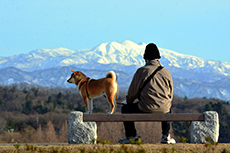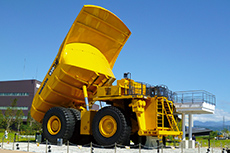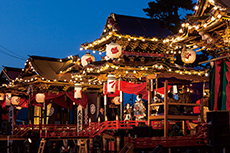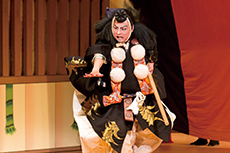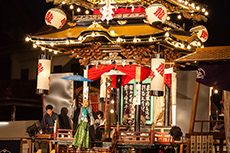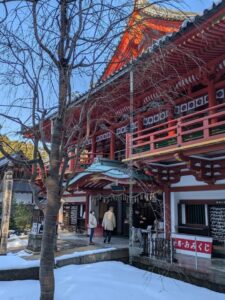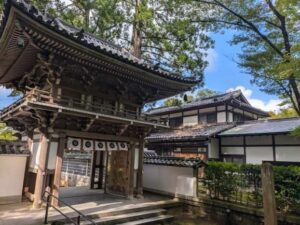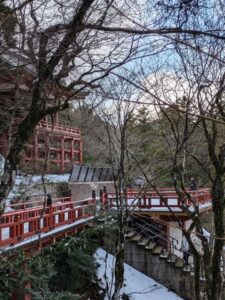What’s New
A Local Treasure: Natadera Temple

A Local Treasure: Natadera Temple
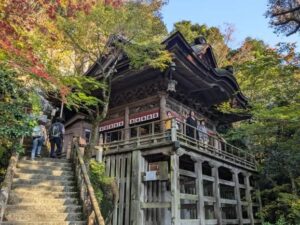
Tucked into the foliage, Natadera rests at the boundary between the foothills of Mt Hakusan and the Kaga plain. Natadera is not a temple complex that uproots nature for its existence but one that embellishes it. Natadera is a temple that revers nature and embraces it.
“But I’ve visited one billion temples since I’ve been in Japan” I hear you say? Not like Natadera however…
The story goes that after visiting Mt Hakusan, Buddhist monk Taicho was said to have been visited by Kannon, the Buddhist goddess of mercy and compassion, and thus founded Natadera in worship of her in the year 717. Natadera’s Temple Grounds are composed of a range of structures, many of which are characteristic of Japanese Buddhist temples, others are specific to Natadera. During the Ikko-ikki uprising of the 15th and 16th centuries in which various rebellious groups rebelled against the ruling samurai class, various elements of Natadera’s temple grounds were destroyed and later rebuilt.
So now that you understand Natadera’s history slightly better, let’s take a take a look at what you’re getting yourself into when you pay the 1000JPN entry fee:
What to look out for:
The main hall (Hondo) – is often the forefront of every temple. They’re often large buildings intricately presented. Natadera’s Hondo, constructed in 1597, is a unique red color and fashions a large statue of Kannon inside. The Hondo usually contains sacred objects of worship. It can also be named kondo, butsuden, amidado or hatto depending on the sect of Buddhism that the temple is. This will likely be the first part of the temple grounds that you visit. For those interested, the seasonal goshuin can be collected from within here. If you don’t already have one, you may even want to consider purchasing one of the beautiful goshuincho that are sold.
The lecture hall (Kodo) – is usually used for meetings and to give teachings. They are also used to display objects of worship. Sadly, a lot of Natadera’s objects of worship were destroyed in the 2024 Noto Peninsula Earthquake.
Pagoda – an iconic structure typically associated with East Asian cultures. Pagodas usually sport 3 or 5 stories (“sanju no to” or “goju no to”) and are said to store a part of the Buddha, such as a tooth, as a representation of the Buddha. Natadera’s Pagoda that dates back to 1642 is a 3 story “sanju no to” that is ornamented with intricately designed wooden carvings and peaks out over the trees within which it is nestled.
Gates – temples are usually introduced by a giant gate that signposts the entry point of the temple grounds. Often in Japanese Buddhist temples, there many multiple gates and entrances to a temple but Natadera features just the one.
Bell – built way back in 1969. These are rung 108 on New Year’s Eve as a representation of the 108 worldly desires in Buddhism.
Specific to Natadera:
Kigan Yusenkyo, Inarisha – is the name of the stunning rock formations that give Natadera it’s iconic scenery. They were formed a very long time ago by the waters that trickled down from Mt Hakusan and flooding from the Sea of Japan. The rock formations are sprinkled with trees that burn a bright crimson color in the Autumn months. The area is no longer available to visitors to climb up due to safety concerns but the masterpiece of nature can be viewed from various parts of the temple grounds.
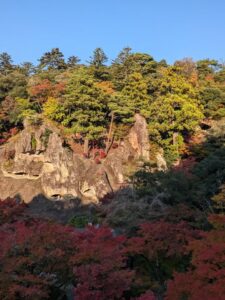 Honden – the main shrine of each shrine. Natadera’s Honden is particularly special due to its location within a naturally formed cave on the side of the Kigan Yusenkyo. After a small climb up a flight of stairs, the viewing platform that frames the wooden jewel provides a spectacular view of the temple grounds from the alternative perspective compared to the viewing platforms that look out onto the Kigan Yusenkyo. Inside in the Honden, there is the main shrine of the temple that protrudes into the cave. Honden are usually features specific to shrines where people pray but Natadera encompasses a unique combination of Buddhist and Shintoist beliefs and thus also has a Honden. Note for those interested, there is also an opportunity to collect a goshuin here too.
Honden – the main shrine of each shrine. Natadera’s Honden is particularly special due to its location within a naturally formed cave on the side of the Kigan Yusenkyo. After a small climb up a flight of stairs, the viewing platform that frames the wooden jewel provides a spectacular view of the temple grounds from the alternative perspective compared to the viewing platforms that look out onto the Kigan Yusenkyo. Inside in the Honden, there is the main shrine of the temple that protrudes into the cave. Honden are usually features specific to shrines where people pray but Natadera encompasses a unique combination of Buddhist and Shintoist beliefs and thus also has a Honden. Note for those interested, there is also an opportunity to collect a goshuin here too.
Tenbodai (viewing platform) can be accessed once you’ve visited the Honden and followed the path past the great pond and Natadera’s Pagoda. You are first met with a suspended path on supports made of wood and painted a striking shade of red that leads to the main area of the Tenbodai. This is typically where the famous photos of the Yusenkyo Kigan.
Gomado is a wooden structure built where the “Goma” ritual takes place. This is a fire-based ceremony where wooden prayer sticks (gomagi) are burnt in a sacred fire as an offering to deities. Natadera’s Gomado was built in 1649.
Seasonal Events
Due to Natadera’s coexistence with nature, the temple complex is a remarkably different experience within each season of the year. Whether it be the fresh radiance of the spring leaves, the radiant glow of the summer sun, the deep crimson ornamentation of autumn’s foliage or the velvety snow of winter, Natadera is a spot that can be revisited every season for a fresh experience.
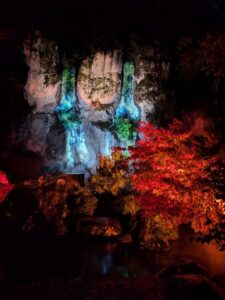
Additionally, keep an eye out and you may be lucky enough to catch any events that are happening on the temple grounds. For example, in the later months of 2024, a company by the name NAKED launched a light-up event each weekend for several weeks in a row in fundraising for the victims of the 2024 Noto Peninsula Earthquake. In this light-up event, the beauty of the autumn foliage was brought out by projection mapping that depicted the ancient water flows that created the rock formations as they stand to this day.
Access:
Accessing Natadera temple can be done through various means. One of the easiest ways may be to drive from nearby Kaga or Komatsu. Alternatively, Natadera’s surroundings make for an excellent scenic route if you were to cycle there. It may be recommended you stop by the nearby Moss Village on your way to Natadera to make for an excellent day trip. Failing that, there are buses from Komatsu Station and Kaga Onsen Station that allow for cheap and easy access to the temple.




